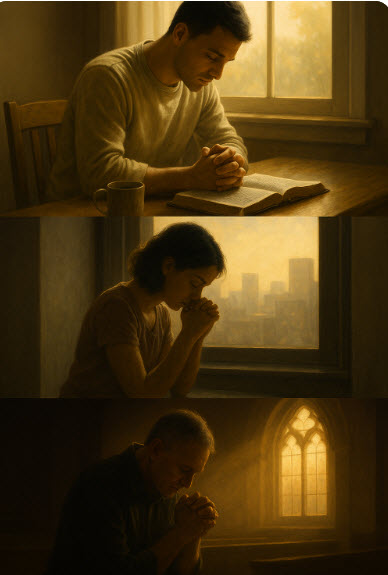In a world obsessed with productivity, efficiency, and constant noise, the idea of pausing to pray at designated hours may seem quaint, even impractical. Yet the ancient practice of observing fixed times for prayer is not a human invention—it is rooted in the Scriptures, developed through centuries of Jewish and Christian tradition, and can serve as a refreshing antidote to the chronic prayerlessness plaguing much of the modern church. This blog post explores the biblical hours of prayer, their historical development, and their potential as a tool—not a rule—for Christians seeking to reorient their lives around the presence and power of God.
The Biblical Hours of Prayer: Three Appointed Times
The Bible refers to three distinct times during the day as “hours of prayer.” These are based on the Jewish and Roman timekeeping systems, which divided the daylight into twelve equal parts from sunrise to sunset. If sunrise is assumed to be around 6:00 AM, then the hours fall as follows:
- The Third Hour (9:00 AM)
Acts 2:15 records Peter declaring that it is the third hour when the Holy Spirit descends at Pentecost. This hour was also the traditional time of the morning sacrifice in the Temple (cf. Exodus 29:38-39). - The Sixth Hour (12:00 Noon)
Peter went up on the rooftop to pray at the sixth hour (Acts 10:9) when he received a vision that would open the door of the Gospel to the Gentiles. It was also the hour when Jesus, wearied, sat by the well and spoke to the Samaritan woman (John 4:6). - The Ninth Hour (3:00 PM)
Described in Acts 3:1 as “the hour of prayer,” Peter and John go to the temple and heal the lame man. It is also the hour when Christ cried out and gave up His spirit on the cross (Matthew 27:46–50), marking a moment of divine sacrifice and fulfillment.
It should be noted that cultural history indicates these hours of prayer were not observed for full hours. The observant Jew may pray for 15-30 minutes. The length of time is not the issue. Regular communion with God throughout the day is the goal.
These times were deeply embedded in Jewish religious life, structured around daily sacrifices and communal worship. For Christians, they took on renewed significance as they became associated with the work and presence of Christ and the outpouring of the Holy Spirit.
Historical Roots: From Jewish Temple to Christian Practice
The practice of praying at specific times can be traced to the daily sacrifices in the Jewish temple, which occurred in the morning and the evening (cf. Exodus 29:38–42). Faithful Jews also prayed three times a day, as modeled by Daniel: “He got down on his knees three times a day and prayed and gave thanks before his God” (Daniel 6:10). These moments—morning, noon, and evening—formed a framework for devotion that kept God at the center of daily life.
In the early church, especially among Jewish believers, this pattern continued. The Book of Acts shows apostles participating in these prayer hours at the Temple. Over time, as Christianity grew apart from its Jewish roots and persecution scattered the early believers, the structure adapted.
By the third and fourth centuries, Christian monasticism began formalizing these prayer hours into what became known as the Liturgy of the Hours or Divine Office. Monks would pray at Terce (9 AM), Sext (12 PM), and None (3 PM), as well as other times such as dawn, dusk, midnight, and before bed. While initially a monastic discipline, aspects of this rhythm became common in the broader church as a way to mark the hours with spiritual significance.
Not a Law, But a Lifeline: Should Christians Practice This Today?
We must be clear: praying at the third, sixth, and ninth hours is not a command for New Testament believers. We are under grace, not law (Romans 6:14). But neither should we discard practices that could rekindle a vibrant prayer life in an age of distraction. These ancient rhythms can serve as helps, not hindrances, for believers who find themselves spiritually dry or inattentive to God throughout the day.
The apostle Paul instructs us to “pray without ceasing” (1 Thessalonians 5:17), and while that doesn’t prescribe specific hours, having set times to pause and reorient our hearts can help us obey that command more practically.
If you’re already devoted to daily prayer and communion with God, praise God. But if you struggle—if prayerlessness has crept in quietly or if your day is filled with activity but no sacred pause—then adopting the biblical hours of prayer can be a spiritual discipline to recalibrate your heart.
The Modern Problem: A Prayerless Church
Prayerlessness is not just a personal failure; it is a crisis in the Church. Many Christians confess that their prayer life is weak, erratic, or virtually nonexistent. Some pastors spend more time planning sermons and meetings than in prayer. Some families never pray together. Others go days or weeks without meaningful communion with God.
This prayerlessness manifests in anxiety, spiritual apathy, powerlessness in witness, moral compromise, and a greater conformity to the world. As E.M. Bounds once wrote, “What the Church needs today is not more machinery or better, not new organizations or more and novel methods, but men whom the Holy Ghost can use—men of prayer.”
Adopting the hours of prayer is not a magic fix, but it is a time-tested structure that can help busy believers reintroduce prayer into their lives in a way that is sustainable and reverent.
Flexibility Over Formality: Grace for Modern Lifestyles
Of course, modern life doesn’t revolve around temple sacrifices or monastery bells. We work long shifts, face commutes, care for children, attend classes, and juggle a thousand responsibilities. Expecting all Christians to drop everything at 9, 12, and 3 may be unrealistic. This is not about legalism or setting up a new checklist of spiritual performance. Jesus warned against meaningless repetition and prayer done for show (Matthew 6:5–7).
Instead, we can think of these hours as reminders—a rhythm of grace that invites us to pause and reconnect with the Lord. Maybe that looks like:
- Setting phone alarms for short pauses to pray at those times.
- Saying a quick prayer during a lunch break.
- Reflecting on Scripture or singing a hymn quietly in your heart while commuting.
- Journaling a brief prayer before or after a meeting.
For those in high-demand roles—mothers, nurses, factory workers, teachers, or truckers—this rhythm must adapt to real life. The point is not exact timing, but consistent connection. Even choosing two fixed times a day to pause and pray can change the tone of your day and revive a sluggish heart.
A Tool for the Weary, Not a Test for the Faithful
Let’s emphasize again: this practice is not for self-righteousness or religious performance. We are not made more holy by hitting exact time slots for prayer. Nor should we look down on those who do not observe them. What matters is the heart behind the discipline.
Just as regular meals nourish the body, regular prayer nourishes the soul. The ancient hours provide “meal times” for the spirit. If a Christian finds himself or herself dry, discouraged, or distracted—these hours can serve as a tool to gently re-establish sacred habits without falling into the trap of works-based faith.
If you miss a prayer time, you haven’t sinned. You haven’t let God down. He’s not keeping score; He’s inviting you to return.
Conclusion: A Call to Recover Sacred Rhythm
In a world of chaos and constant connectivity, Christians need sacred rhythms more than ever. The ancient hours of prayer are not a rigid formula but a wise framework—a way of anchoring our hearts to God throughout the day. They remind us that every hour is God’s hour, every moment an opportunity to commune with our Father.
Maybe you don’t need this practice. But if your heart has grown cold, your days have become cluttered, and your connection with God feels distant, this forgotten discipline might be the simple structure that brings you back to your knees—not in guilt, but in grace.
S.D.G.,
Robert Sparkman
rob@christiannewsjunkie
RELATED CONTENT
Concerning the Related Content section, I encourage everyone to evaluate the content carefully.
Some sources of information may reflect a libertarian and/or atheistic perspective. I may not agree with all of their opinions, but they offer some worthwhile comments on the topic under discussion.
Additionally, language used in the videos may be coarse. Coarse language does not reflect my personal standards.
Finally, those on the left often criticize my sources of information, which are primarily conservative and/or Christian. Truth is truth, regardless of how we feel about it. Leftists are largely led by their emotion rather than facts. It is no small wonder that they would criticize the sources that I provide. And, ultimately, my wordview is governed by Scripture. Many of my critics are not biblical Christians.
Feel free to offer your comments below. Respectful comments without expletives and personal attacks will be posted and I will respond to them.
Comments are closed after sixty days due to spamming issues from internet bots. You can always send me an email at rob@christiannewsjunkie.com if you want to comment on something, though.
I will continue to add items to the Related Content section as opportunities present themselves.

